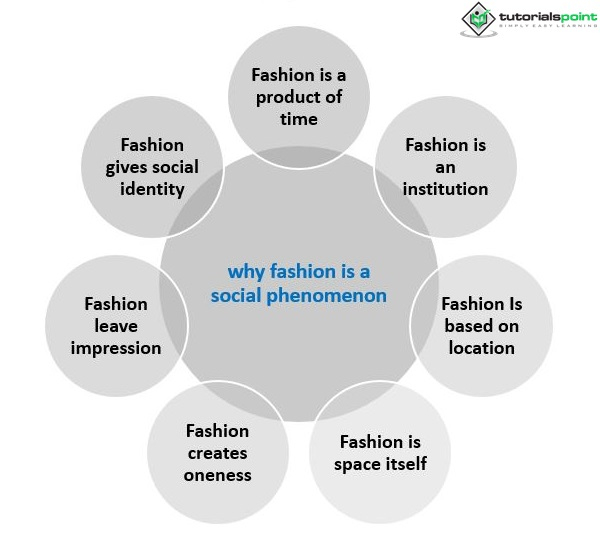

The way a person dresses communicates a lot about their sense of style and personality. In addition, fashion shows how ideas develop through time, starting as fads but eventually becoming accepted as styles in society, which are a more rigid and established version of their former forms.

Fashion is a social phenomenon that draws individuals from all walks of life because it encourages interaction and brings people together. Many spheres of human endeavour and thought share a commonality with fashion. High-status consumers (including celebrities) and affiliated fashion designers, as well as fashion houses, tend to play some role in shaping the rates and directions of fashion change. Fashion is everywhere—in the sky, on the street—and it has to do with our beliefs, our way of life, and current events.
Only in societies where there is a chance that some social classes or groups may copy others by passing along distinct cultural patterns will fashion permeate every social cell. If we try to compare fashion with something substantive based on prior experience, we may claim that in the twenty-first century it is striving for progressive institutionalization. The role of fashion is that of a social regulator, highlighting social inequity while also minimising inequalities across social groupings. It serves as a way to make an impression in addition to serving as a way to demonstrate social rank.
Fashion is a phenomenon that, through time, has conquered more and larger portions of the market and has gradually permeated the corporate sector. There are many studies that go into the fashion industry and the making of a couture dress, fusing the artist’s creativity with the capacity for the clothing to be real while also preserving the wearer’s freedom to be and feel however they choose.

Fashion is a product of time because it moves hand in hand with history. It is a manifestation of the current and historical spirit. Without denying the past or focusing on the future, it captures society as it is today. Fashion, in actuality, “fishes out” the past, portrays the present, and looks ahead to the future. It is constantly evolving and never stops.
According to Carl Menger, fashion has been an institution since it emerged spontaneously, exactly like religion and money, the two most significant social institutions. In this way, institutions carry so much knowledge that has been accumulated over the course of their evolution that neither a man nor a social consensus could have created them. Fashion is therefore an institution. It is a spontaneous gathering that neither of them could have planned or imagined. Although many individuals view it as pointless or futile, it also has an impact on those who choose to remain outside of it.
Although it sets the “overall guideline” during specific historical periods, fashion is based on location since it is the reflection of specific cultures. So, what we’ll see is the play of materials, details, and designs that characterise the many clothes that express different civilizations. On an Indian runway, silks, tunics, and turbans are never in short supply. Neither will the burkas and veils worn by Arab women. Therefore, we might conclude that fashion represents a location and its traditions.
Fashion is also a universal phenomenon. It is unconstrained. It travels through space to spread its message everywhere, bringing the numerous civilizations it represents with it and affecting them mutually. This has led to the universalization of jeans and the debut of turbans on Italian catwalks. In this sense, clothing might be viewed as a democratic component. It expresses both an individual and a community viewpoint, as well as a sense of identity and distinction. The trend, according to Simmel, “displays a distinctive manner of living, where one attempts to find a compromise between the tendency of social equality and individual stimulation.”
Fashion shapes us. The rules of our society are expressed in it. Man, who by definition is a social animal, cannot escape from this exquisite machinery. In fact, if a man disobeyed societal norms, he would be a social outcast and subject to public punishment; for this reason, everyone respects fashion, even if just subliminally. This is how fashion’s power reveals itself: by giving each individual a secure place in society and the chance to always conform to every circumstance in accordance with accepted norms.
We can classify the person in front of us based on their clothing, including their personality (whether they are neat, well-groomed, more or less self-conscious, employed or not, sad or cheerful, etc.), as well as their socioeconomic class or political philosophy. Fashion serves as both a societal and a personal identity.It allows us to gain entry into specific social rings while expressing who we are or aspire to be in society. As a result, people feel more independent and socially connected. Every style carries an ideology with it; it represents a particular trend. Because of this, based on the other person’s clothing choices, our brain can classify them into various social groupings.
Thanks to fashion, everyone can adhere to the broad rules that are consistent with their social identity. To avoid “social punishment,” everyone abides by these rules. However, within these bounds, fashion permits anyone to use it to set themselves apart from one another. Because it is a manifestation of the ego, it is a personal expression. We are unsure if this ego is genuine or artificial. Since everyone may create countless images of themselves, anyone can profit from this game of seduction. We can express both who we are and who we are not through our choice of clothing. But we have to be careful not to lose the disguise we’ve given ourselves. We show the world our business cards by how we dress and whether or not we follow fashion.
To conclude, fashion is a social phenomenon that demonstrates its influence on both individual identity and societal conscience. Without people realising it, it has the power to affect both the general public and an individual. As Carl Menger put it, “Fashion is an institution since, much like religion and money, the most significant social institutions have emerged spontaneously.”
Fashion is power, and this force imposes itself on society while also being the representation of that culture and setting the rules that must be followed. Fashion is communication because it combines individual and collective expression, belonging and differentiation, time, location, and space. Nobody can avoid the phenomenon known as “fashion.” Everyone can adhere to the societal norms that complement their social identity thanks to fashion.